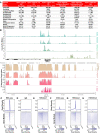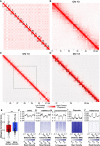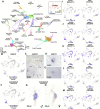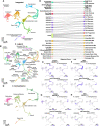A chromosome-scale epigenetic map of the Hydra genome reveals conserved regulators of cell state
- PMID: 36639202
- PMCID: PMC10069465
- DOI: 10.1101/gr.277040.122
A chromosome-scale epigenetic map of the Hydra genome reveals conserved regulators of cell state
Abstract
The epithelial and interstitial stem cells of the freshwater polyp Hydra are the best-characterized stem cell systems in any cnidarian, providing valuable insight into cell type evolution and the origin of stemness in animals. However, little is known about the transcriptional regulatory mechanisms that determine how these stem cells are maintained and how they give rise to their diverse differentiated progeny. To address such questions, a thorough understanding of transcriptional regulation in Hydra is needed. To this end, we generated extensive new resources for characterizing transcriptional regulation in Hydra, including new genome assemblies for Hydra oligactis and the AEP strain of Hydra vulgaris, an updated whole-animal single-cell RNA-seq atlas, and genome-wide maps of chromatin interactions, chromatin accessibility, sequence conservation, and histone modifications. These data revealed the existence of large kilobase-scale chromatin interaction domains in the Hydra genome that contain transcriptionally coregulated genes. We also uncovered the transcriptomic profiles of two previously molecularly uncharacterized cell types: isorhiza-type nematocytes and somatic gonad ectoderm. Finally, we identified novel candidate regulators of cell type-specific transcription, several of which have likely been conserved at least since the divergence of Hydra and the jellyfish Clytia hemisphaerica more than 400 million years ago.
© 2023 Cazet et al.; Published by Cold Spring Harbor Laboratory Press.
Figures





Similar articles
-
PIWI proteins and PIWI-interacting RNAs function in Hydra somatic stem cells.Proc Natl Acad Sci U S A. 2014 Jan 7;111(1):337-42. doi: 10.1073/pnas.1320965111. Epub 2013 Dec 23. Proc Natl Acad Sci U S A. 2014. PMID: 24367095 Free PMC article.
-
Molecular evolution and expression of opsin genes in Hydra vulgaris.BMC Genomics. 2019 Dec 17;20(1):992. doi: 10.1186/s12864-019-6349-y. BMC Genomics. 2019. PMID: 31847811 Free PMC article.
-
A possible role for the cnidarian homologue of serum response factor in decision making by undifferentiated cells.Dev Biol. 2001 Aug 15;236(2):304-15. doi: 10.1006/dbio.2001.0335. Dev Biol. 2001. PMID: 11476573
-
The Hydra stem cell system - Revisited.Cells Dev. 2023 Jun;174:203846. doi: 10.1016/j.cdev.2023.203846. Epub 2023 Apr 28. Cells Dev. 2023. PMID: 37121433 Review.
-
Robust G2 pausing of adult stem cells in Hydra.Differentiation. 2014 Jan-Feb;87(1-2):83-99. doi: 10.1016/j.diff.2014.03.001. Epub 2014 Apr 2. Differentiation. 2014. PMID: 24703763 Review.
Cited by
-
Terminal differentiation precedes functional circuit integration in the peduncle neurons in regenerating Hydra vulgaris.Neural Dev. 2024 Oct 4;19(1):18. doi: 10.1186/s13064-024-00194-2. Neural Dev. 2024. PMID: 39367491 Free PMC article.
-
Flexible use of conserved motif vocabularies constrains genome access in cell type evolution.bioRxiv [Preprint]. 2024 Sep 6:2024.09.03.611027. doi: 10.1101/2024.09.03.611027. bioRxiv. 2024. PMID: 39282369 Free PMC article. Preprint.
-
Web of venom: exploration of big data resources in animal toxin research.Gigascience. 2024 Jan 2;13:giae054. doi: 10.1093/gigascience/giae054. Gigascience. 2024. PMID: 39250076 Free PMC article.
-
Phototaxis is a satiety-dependent behavioral sequence in Hydra vulgaris.J Exp Biol. 2024 Sep 15;227(18):jeb247503. doi: 10.1242/jeb.247503. Epub 2024 Sep 25. J Exp Biol. 2024. PMID: 39155640 Free PMC article.
-
Novel technologies uncover novel 'anti'-microbial peptides in Hydra shaping the species-specific microbiome.Philos Trans R Soc Lond B Biol Sci. 2024 May 6;379(1901):20230058. doi: 10.1098/rstb.2023.0058. Epub 2024 Mar 18. Philos Trans R Soc Lond B Biol Sci. 2024. PMID: 38497265 Free PMC article.
References
Publication types
MeSH terms
Substances
Grants and funding
LinkOut - more resources
Full Text Sources

